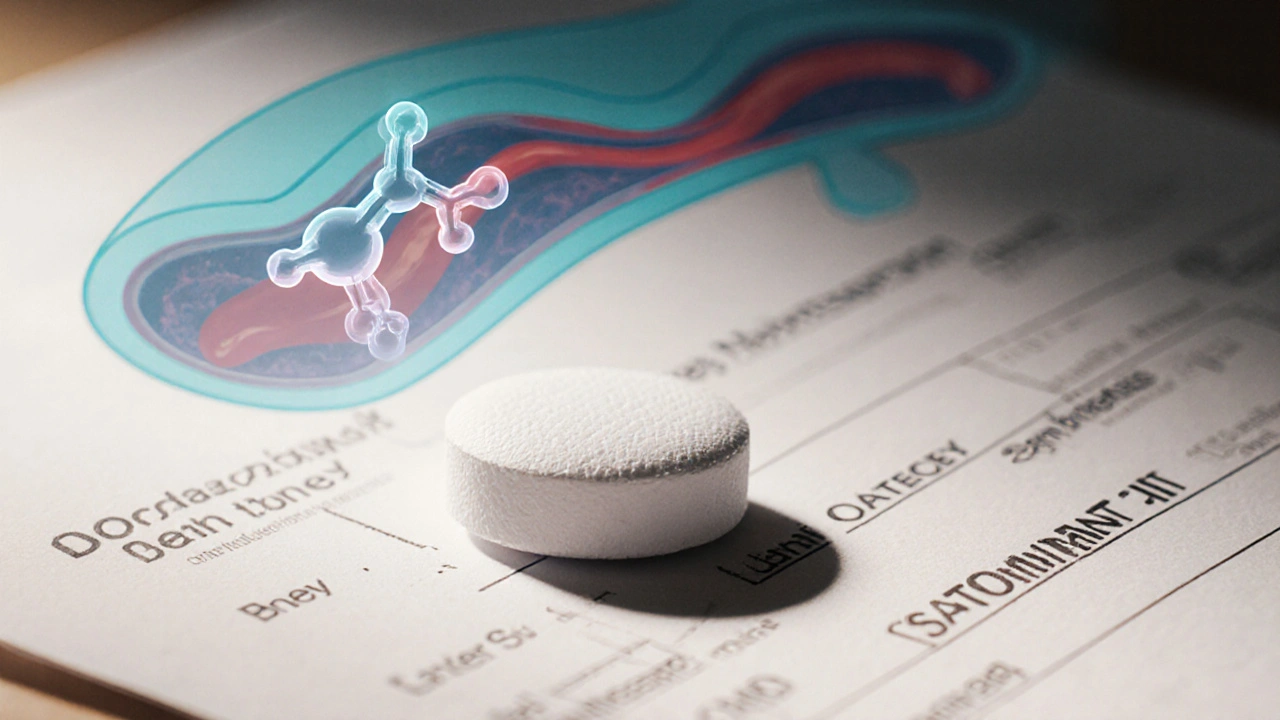Sartel (Telmisartan) vs Other Blood Pressure Drugs: Full Comparison Guide

Sartel vs Other Blood Pressure Drugs Comparison Tool
Sartel (Telmisartan)
Class: Angiotensin II Receptor Blocker (ARB)
Typical Dose: 40-80 mg once daily
Key Benefit: Renal protective effects in diabetic kidney disease
Losartan (Cozaar)
Class: Angiotensin II Receptor Blocker (ARB)
Typical Dose: 50-100 mg once daily
Key Benefit: Longest market history, well-studied
Valsartan (Diovan)
Class: Angiotensin II Receptor Blocker (ARB)
Typical Dose: 80-160 mg once daily
Key Benefit: Longer half-life for night dosing
Olmesartan (Benicar)
Class: Angiotensin II Receptor Blocker (ARB)
Typical Dose: 20-40 mg once daily
Key Benefit: Strong BP reduction at lower doses
Side Effects Comparison
Common Side Effects
- Sartel Dizziness, fatigue, mild headache
- Losartan Dizziness, back pain, sinusitis
- Valsartan Headache, abdominal pain
- Olmesartan Dizziness, fatigue, nausea
- Lisinopril Cough, dizziness
Serious Side Effects
- Sartel Angioedema, kidney function decline
- Losartan Hyperkalemia, renal impairment
- Valsartan Angioedema, severe hypotension
- Olmesartan Sprue-like enteropathy (rare)
- Lisinopril Angioedema, hyperkalemia, renal failure
Cost Comparison Calculator
Important Notes
- All ARBs have a low risk of cough compared to ACE inhibitors
- Cost varies significantly between brand and generic versions
- Always consult your doctor before switching medications
- Generic Telmisartan has the same active ingredient as Sartel
Sartel (Telmisartan) is often the name that pops up when patients search for a pill to tame high blood pressure. But is it the best fit, or do other options deliver better control, fewer side effects, or a friendlier price tag? This guide breaks down Sartel, lines it up against the most common alternatives, and gives you a clear roadmap for deciding what works for you.
- Understand what Sartel contains and how it lowers blood pressure.
- See a side‑by‑side table of Sartel, other Telmisartan brands, and rival ARBs.
- Compare efficacy, side‑effects, and typical dosing.
- Get realistic cost figures and insurance tips.
- Learn how to switch safely if another drug looks better.
What is Sartel and how does Telmisartan work?
When it comes to managing high blood pressure, Sartel is a brand‑name tablet that contains the active ingredient Telmisartan, an angiotensinII receptor blocker (ARB). Telmisartan works by blocking the hormone angiotensinII from tightening blood vessels, which lets the arteries stay relaxed and the heart pump more easily. The result? A steady drop in systolic and diastolic pressure, usually within a week of starting therapy.
Key attributes of Telmisartan:
- Typical daily dose: 40mg to 80mg, taken once a day.
- Half‑life of about 24hours, which means once‑daily dosing fits most lifestyles.
- Proven to improve renal outcomes in patients with diabetes‑related kidney disease.
Because Sartel is just one brand of Telmisartan, its clinical effects mirror those of any generic Telmisartan tablet. The differences usually come down to price, filler ingredients, and how the drug is marketed.
Key alternatives to Sartel
If you’re hunting for a different ARB or even an ACE inhibitor, a handful of names dominate the market.
- Losartan is the first‑approved ARB, often sold under the brand name Cozaar. It’s a solid, well‑tolerated option for most patients.
- Valsartan (brand Diovan) offers a slightly longer half‑life, which can be handy for nighttime dosing.
- Olmesartan (brand Benicar) tends to have a stronger blood‑pressure‑lowering effect at lower doses.
- Lisinopril is an ACE inhibitor, not an ARB, but many clinicians use it as a first‑line alternative when ARBs cause cough.
Beyond these, you’ll see multiple generic Telmisartan manufacturers-Micard, Telfil, Tenorm-each offering the same molecule in slightly different pill shapes and excipients.
Side‑effect profile comparison
All ARBs share a core safety record: low incidence of cough and no rise in potassium levels as dramatic as ACE inhibitors. Still, tiny differences matter.
| Drug | Typical side effects | Less‑common but serious |
|---|---|---|
| Sartel (Telmisartan) | Dizziness, fatigue, mild headache | Angio‑edema (rare), kidney function decline |
| Losartan | Dizziness, back pain, sinusitis | Hyperkalemia, renal impairment |
| Valsartan | Headache, cough, abdominal pain | Angio‑edema, severe hypotension |
| Olmesartan | Dizziness, fatigue, nausea | Sprue‑like enteropathy (very rare) |
| Lisinopril | Cough, taste disturbances, dizziness | Angio‑edema, hyperkalemia, renal failure |
Notice how the cough that plagues ACE inhibitors isn’t a big deal for any ARB, including Sartel. If a patient reports a persistent dry cough, the doctor often swaps an ACE inhibitor for an ARB.

Cost and insurance considerations
Price is the real deal‑breaker for many users. Because Sartel is a branded product, it typically sits a notch higher than generic Telmisartan.
- Sartel (brand) - approx. $45USD for a 30‑day supply of 40mg tablets.
- Generic Telmisartan (Micard, Telfil) - $15‑$25USD for the same supply.
- Losartan (generic) - $12‑$20USD per month.
- Valsartan (generic) - $18‑$30USD per month.
- Lisinopril (generic) - $5‑$12USD per month, often the cheapest antihypertensive.
Insurance plans usually list “Telmisartan” as the generic name, so a claim for Sartel may be processed at the brand‑price tier unless the patient opts for a lower‑cost generic. Checking the plan’s formulary beforehand can save dozens of dollars a year.
Choosing the right ARB for you
Here’s a quick decision tree you can run through with your clinician:
- Do you have a history of cough with ACE inhibitors? Yes → ARB is a safer bet (any brand, including Sartel).
- Is cost a primary concern? Yes → Choose a generic Telmisartan or switch to Losartan.
- Do you have chronic kidney disease? Yes → Telmisartan (Sartel) has solid data for renal protection; keep an eye on labs.
- Do you need once‑daily dosing with a long half‑life? Yes → Sartel or Valsartan work well.
- Any allergy to sulfonamides (rare in ARBs)? Yes → Discuss alternative classes with your doctor.
In practice, the “best” drug is the one you can take consistently without side effects and that fits your budget.
How to switch safely
Switching from Sartel to another ARB or to an ACE inhibitor doesn’t require a wash‑out period, but you should follow these steps:
- Schedule an appointment and bring your current prescription label.
- Ask the doctor to write a new prescription that matches the same daily dose (e.g., 40mg of Telmisartan ≈ 50mg of Losartan).
- Fill the new prescription at a pharmacy that offers a price‑comparison tool.
- Take the new pill at the same time each day; monitor blood pressure for the first two weeks.
- Report any new dizziness, swelling, or cough immediately.
Never stop the medication on your own - even a short gap can cause a rebound rise in blood pressure.
Quick comparison table
| Brand | Generic name | Typical daily dose | Monthly cost (USD) | Key advantage |
|---|---|---|---|---|
| Sartel | Telmisartan | 40‑80mg | ~45 | Renal‑protective data, once‑daily |
| Micard (generic) | Telmisartan | 40‑80mg | 15‑25 | Lowest price for same molecule |
| Cozaar | Losartan | 50‑100mg | 12‑20 | Longest market history, well‑studied |
| Diovan | Valsartan | 80‑160mg | 18‑30 | Long half‑life, good for night dosing |
| Benicar | Olmesartan | 20‑40mg | 22‑35 | Strong BP reduction at low dose |
| Generic Lisinopril | Lisinopril | 10‑40mg | 5‑12 | Cheapest ACE inhibitor, solid evidence |
Use this table as a starting point, then bring your personal health data to the conversation.

Frequently Asked Questions
What makes Sartel different from other Telmisartan brands?
Sartel is the branded version of Telmisartan. Its active ingredient, dosage, and mechanism are identical to generic Telmisartan tablets. The differences lie in the excipients (inactive fillers), the pill’s appearance, and the price - brand‑name versions usually cost more than generics.
Can I switch from Sartel to Losartan without a doctor’s order?
No. Even though both drugs belong to the ARB class, they have different dosing equivalents. A doctor needs to calculate the right Losartan dose and check for drug interactions before you make the switch.
Why does my doctor sometimes prescribe an ACE inhibitor instead of an ARB?
ACE inhibitors like Lisinopril are usually cheaper and have a longer track record. They’re often the first choice unless you have a history of cough or angio‑edema, in which case an ARB such as Sartel is safer.
Is it safe to take Sartel with a potassium‑rich diet?
ARBs can modestly raise potassium levels, but most patients tolerate a normal diet. If you have kidney disease or are on a potassium supplement, your doctor will monitor blood levels regularly.
How long does it take for Sartel to show its full effect?
Because Telmisartan’s half‑life is about 24hours, most patients see a noticeable drop in blood pressure within 1‑2 weeks. Full steady‑state effect may take up to 4 weeks, so doctors usually re‑check numbers at the 4‑week mark.

Shelby Wright
October 3, 2025 AT 09:17Honestly, who needs another bland ARB comparison when you can turn the dosage chart into a fireworks display of side‑effects? Sartel sounds like a superhero cape for kidneys, but the price tag makes it feel like a villain. If you’re looking for drama, just stare at the cost calculator and watch the numbers melt away.
Ellen Laird
October 3, 2025 AT 09:33One might posit that the nuanced pharmacokinetic profile of Telmisartan eclipses the pedestrian nature of its rivals, yet the prose herein occasionally suffers from a egregious lack of ortographic rigour. The cost analysis, for instance, appears to be interlaced with typographical misadventures that could befuddle the uninitiated.
rafaat pronoy
October 3, 2025 AT 09:50Cool breakdown, the half‑life info is spot on 😊. Quick tip: you can usually grab a generic Telmisartan for a fraction of the price and still get the same kidney‑protective vibe.
sachin shinde
October 3, 2025 AT 10:07While the article admirably enumerates the comparative pharmacodynamics, it regrettably neglects to consistently employ the Oxford comma, thereby compromising syntactic clarity. Moreover, the assertion that “all ARBs share a core safety record” is overly broad; subtle variations in receptor affinity warrant precise delineation. A reader benefits from exactitude, not from generalized platitudes.
Leon Wood
October 3, 2025 AT 10:23Great job laying out the options! It’s empowering to see that you can pick a drug that suits both your health goals and your wallet. Keep this guide handy, and you’ll stay on top of your blood pressure journey.
George Embaid
October 3, 2025 AT 10:40When navigating the labyrinth of antihypertensive therapy, cultural context often shapes patient preferences as much as pharmacology does. In many communities, the brand name carries a perception of higher quality, even when generics are chemically identical. This perception can influence adherence, especially when trust in the healthcare system varies. Recognizing these nuances allows clinicians to tailor conversations that respect patients’ backgrounds. For instance, explaining that Sartel’s active ingredient, Telmisartan, is the same molecule found in cheaper generics can demystify cost concerns. Simultaneously, highlighting the renal‑protective data may resonate with patients managing diabetes, a condition prevalent in diverse ethnic groups. It is also crucial to address language barriers; offering educational material in multiple languages improves comprehension. Moreover, involving family members in the decision‑making process aligns with collectivist values common in many cultures. From a socioeconomic standpoint, the disparity between a $45 monthly brand and a $15 generic is not trivial; it can determine whether a patient fills the prescription consistently. Insurance formularies often incentivize generic use, but prior authorizations can delay access, creating gaps in therapy. Clinicians should proactively verify coverage to prevent those interruptions. Additionally, being aware of dietary patterns that affect potassium levels can preempt adverse events, particularly in populations with high potassium intake. Open dialogue about potential side effects, like the rare but serious angio‑edema, builds trust and encourages prompt reporting. When patients feel heard, they are more likely to maintain lifestyle modifications alongside medication. Ultimately, the best choice is the one the patient can afford, tolerate, and understand, supported by culturally sensitive education. By integrating these considerations, we move beyond a one‑size‑fits‑all algorithm toward truly patient‑centered care.
Meg Mackenzie
October 3, 2025 AT 10:57While the guide paints a rosy picture, have you considered that the pharmaceutical giants might be inflating prices to keep us dependent? The $45 tag on Sartel feels less like a market price and more like a profit scheme engineered to siphon money from unsuspecting patients.
Henry Kim
October 3, 2025 AT 11:13I hear your concerns, and it’s understandable to feel wary of cost structures, yet many generic manufacturers also operate on slim margins. Sharing verified pricing sources can help demystify the actual financial landscape without veering into speculation.
Neha Bharti
October 3, 2025 AT 11:30Choosing a medication mirrors the Stoic principle of aligning external actions with internal values; the most prudent path respects both health and fiscal prudence.
Samantha Patrick
October 3, 2025 AT 11:47Here’s a quick tip: if your insurance lists “Telmisartan,” you can usually request the generic version at the pharmacy and save a bunde. Just tell them you want the “generic telmisartan” instead of the brand name.
Ryan Wilson
October 3, 2025 AT 12:03It’s amusing how some people cling to the brand name as if it were a status symbol, when in reality the molecule is identical across the board.
EDDY RODRIGUEZ
October 3, 2025 AT 12:20Great advice! I’ve tried the generic route and saw a noticeable drop in my monthly expenses, which meant I could reinvest that saved money into healthier food choices.
Christopher Pichler
October 3, 2025 AT 12:37Ah, the ever‑elusive “formulary tier” – a concept that seems straight out of a bureaucratic playbook. Navigating it requires a mastery of health‑economics lingo that most patients simply don’t have time for.
VARUN ELATTUVALAPPIL
October 3, 2025 AT 12:53Wow!!! This comparison is... incredibly... thorough; however, one might wonder-why does every drug profile... contain a list of side‑effects-especially when some of them are... extremely rare???
April Conley
October 3, 2025 AT 13:10Skip the brand, grab the generic.
Sophie Rabey
October 3, 2025 AT 13:27Sure, because spending less on meds automatically means you’ll live forever-right? But hey, at least you’ll have extra cash for that “healthy” kale smoothie you keep hearing about.
Bruce Heintz
October 3, 2025 AT 13:43Glad you found the table useful! If you need help comparing your own prescription costs, just drop a line here 😊.
richard king
October 3, 2025 AT 14:00The quest for optimal blood pressure control is, in essence, a microcosm of humanity’s perpetual struggle against unseen forces; we prescribe molecules, yet the true alchemy lies in the balance between science, economics, and the soul’s yearning for longevity. In the theater of medicine, Sartel plays the charismatic lead, while its generics assume the diligent understudies, ever ready to step into the spotlight when the audience demands frugality. This dichotomy reminds us that every dosage is a stanza in the larger poem of existence, where the rhythm of the heart mirrors the cadence of our choices.